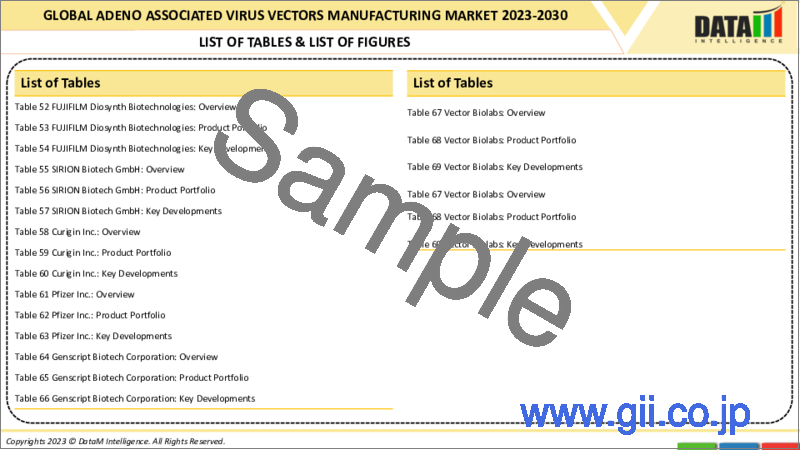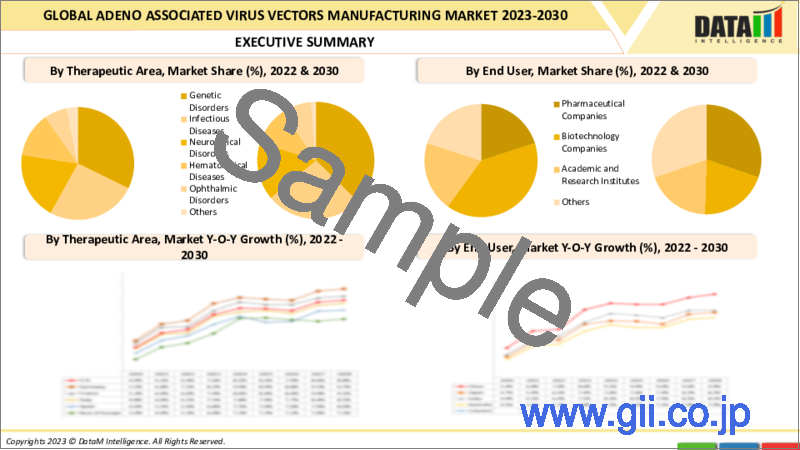|
|
市場調査レポート
商品コード
1374844
アデノ随伴ウイルスベクター製造の世界市場-2023年~2030年Global Adeno Associated Virus Vectors Manufacturing Market - 2023-2030 |
||||||
カスタマイズ可能
適宜更新あり
|
|||||||
| アデノ随伴ウイルスベクター製造の世界市場-2023年~2030年 |
|
出版日: 2023年11月01日
発行: DataM Intelligence
ページ情報: 英文 188 Pages
納期: 即日から翌営業日
|
- 全表示
- 概要
- 目次
概要
アデノ随伴ウイルス(AAV)ベクターは複製不全の一本鎖DNAパルボウイルスであり、その複製にはヘルパーAdが必要です。ヘルパーウイルスが存在しない場合、AAVベクターは宿主細胞ゲノムに部位特異的またはランダムに組み込まれ、長期間の導入遺伝子発現をもたらします。さらに、アデノ随伴ウイルスベクターは、広範囲の静止および分裂中の標的細胞で高い導入効率を示します。Adsとは対照的に、AAVベクターは重大な免疫反応を引き起こしません。
さらに、アデノ随伴ウイルスベクターは遺伝病やがんの遺伝子治療により頻繁に使用されています。さらに、アデノ随伴ウイルスベクターを介した遺伝子導入は、遺伝性失明症や脊髄性筋萎縮症、長期治療効果、血友病やデュシェンヌ型筋ジストロフィーなどの希少疾患の治療にも承認されています。また、多くの疾患を治療するための細胞療法やワクチン製造にも利用されています。
市場力学:促進要因
アデノ随伴ウイルスベクターの採用増加
アデノ随伴ウイルスベクターの採用増加は、予測期間中、市場を牽引すると予想されます。採用の増加は、より多くの製造プラットフォームの立ち上げに注力するようになります。例えば、2023年5月16日、AGC Biologics社はBravoAAVとProntoLVVウイルスベクタープラットフォームを発表しました。レンチウイルスベクター(LVV)とアデノ随伴ウイルスベクター(AAV)の30年にわたる開発、製造、分析の経験を生かし、AGC Biologicsの新しいプラットフォームは、迅速、効率的、再現性の高い臨床および商業GMP製造とリリースを提供します。
さらに、2022年10月10日、チャールズ・リバー・ラボラトリーズ・インターナショナル社は、nAAVigationベクター・プラットフォーム(nAAVigation)を発表しました。数十年にわたるアデノ随伴ウイルス(AAV)ベクターの開発・製造受託(CDMO)の経験と生物製剤試験の専門知識を活用し、チャールズリバーは、大規模なプロセス開発を必要とせずにGMP AAVベクター製造への道筋を合理化するプラットフォームを確立しました。
さらに、アデノ随伴ウイルスベクターは多くの疾患の治療に使用されているため、アデノ随伴ウイルスベクターの採用がさらに増加しています。例えば、2023年3月2日、FDAから臨床使用の承認を受けた最初のベクター送達遺伝子治療は、スパーク・セラピューティクスの視力低下治療薬Luxturnaとノバルティスの脊髄性筋萎縮症治療薬Zolgensmaでした。加えて、これらは遺伝子治療デリバリー技術に対する需要の急増をもたらしました。この急増は現在も続いています。現在、ベクターの設計と製造における技術革新が刺激されています。
さらに、アデノ随伴ウイルスベクターは遺伝子治療に最も一般的に応用されており、これも採用をさらに増加させています。例えば、2023年3月9日、Charles River Laboratories International, Inc.は、供給を確保し、アデノ随伴ウイルス(AAV)ベースの遺伝子治療プログラムを初期の発見から商業的製造まで合理化するために設計された、既製のpHelperの提供を開始しました。
さらに、遺伝性疾患、感染症、神経疾患、眼科疾患、その他の慢性疾患の有病率の増加、FDA承認の増加、臨床試験の増加、新規治療法やワクチンの開発における認知度の向上と進歩が、予測期間にわたって市場を牽引すると予想される要因です。
阻害要因
高い製造コスト、熟練した専門家の不足、限られたクローニング能力などの要因が市場の妨げになると予想されます。
目次
第1章 調査手法と調査範囲
第2章 定義と概要
第3章 エグゼクティブサマリー
第4章 市場力学
- 影響要因
- 促進要因
- アデノ随伴ウイルスベクターの採用増加
- 抑制要因
- 高い製造コスト
- 機会
- 影響分析
- 促進要因
第5章 産業分析
- ポーターのファイブフォース分析
- サプライチェーン分析
- 価格分析
- 規制分析
- パイプライン分析
- アンメットニーズ
- 特許分析
- DMIのオピニオン
第6章 COVID-19分析
第7章 方法別
- In Vivo(生体内)
- In Vitro(生体外)
第8章 応用別
- 遺伝子治療
- 細胞治療
- ワクチン製造
- その他
第9章 治療領域別
- 遺伝子疾患
- 感染症
- 神経疾患
- 血液疾患
- 眼科疾患
- その他
第10章 エンドユーザー別
- 製薬会社
- バイオテクノロジー企業
- 学術・研究機関
- その他
第11章 地域別
- 北米
- 米国
- カナダ
- メキシコ
- 欧州
- ドイツ
- 英国
- フランス
- イタリア
- スペイン
- その他欧州
- 南米
- ブラジル
- アルゼンチン
- その他南米
- アジア太平洋
- 中国
- インド
- 日本
- オーストラリア
- その他アジア太平洋
- 中東・アフリカ
第12章 競合情勢
- 競合シナリオ
- 市況/シェア分析
- M&A分析
第13章 企業プロファイル
- Thermo Fisher Scientific Inc.
- 会社概要
- 製品ポートフォリオと説明
- 財務概要
- 主な動向
- Oxford Biomedica PLC
- Lonza Ltd
- uniQure N.V.
- FUJIFILM Diosynth Biotechnologies
- SIRION Biotech GmbH
- Curigin Inc.
- Pfizer Inc.
- Genscript Biotech Corp
- Vector Biolabs
第14章 付録
Overview
Adeno-associated viral (AAV) vectors are replication-defective, single-stranded DNA parvoviruses, which require a helper Ad for their replication. Site-specific or random AAV vector integration into the host cell genome, in the absence of a helper virus, results in long-term transgene expression. Additionally, adeno-associated viral vectors demonstrate high transduction efficiency in a broad range of quiescent and dividing target cells. In contrast to Ads, AAV vectors do not produce a significant immune response.
Moreover, adeno-associated viral vectors are more frequently used for gene therapy for genetic diseases and cancer. In addition, adeno-associated virus vector-mediated gene delivery is also approved for the treatment of inherited blindness and spinal muscular atrophy, long-term therapeutic effects and other rare diseases, including hemophilia and Duchenne muscular dystrophy. They are also considered in cell therapy and vaccine production to treat many diseases.
Market Dynamics: Drivers
Increasing adoption of adeno-associated viral vectors
The increasing adoption of adeno-associated viral vectors is expected to drive the market over the forecast period. The increasing adoption leads to an increasing focus on launching more manufacturing platforms. For instance, on May 16, 2023, AGC Biologics launched its BravoAAV and ProntoLVV viral vector platforms. Leveraging three decades of Lentiviral vector (LVV) and Adeno-Associated Viral vector (AAV) development, manufacturing and analytical experience, AGC Biologics' new platforms offer fast, efficient and reproducible clinical and commercial GMP production and release.
Additionally, on October 10, 2022, Charles River Laboratories International, Inc. launched its nAAVigation Vector Platform (nAAVigation). Leveraging decades of Adeno-Associated Virus (AAV) vector contract development and manufacturing (CDMO) experience and biologics testing expertise, Charles River has established a platform that streamlines the pathway to GMP AAV vector manufacturing without the need for significant process development.
Moreover, the adeno-associated viral vectors are mostly used to treat many diseases, this further increases the adoption of adeno-associated virus vectors. For instance, on March 02, 2023, the first vector-delivered gene therapies to receive FDA approval for clinical use were Luxturna, Spark Therapeutics vision loss cure, and Zolgensma, Novartis' spinal muscular atrophy treatment. In addition, they brought about a surge in demand for gene therapy delivery technologies. The surge is ongoing. Currently, it is stimulating innovation in vector design and manufacturing.
Furthermore, adeno-associated virus vectors are most commonly applicable for gene therapy, which also further increases the adoption. For instance, on March 9, 2023, Charles River Laboratories International, Inc. launched its off-the-shelf pHelper offering, which is designed to secure supply and streamline adeno-associated virus (AAV)-based gene therapy programs from early discovery through commercial manufacturing.
Further, the increasing prevalence of genetic, infectious, neurological, ophthalmic and other chronic disorders, rising FDA approvals, increasing clinical trials, increasing awareness and advancements in the development novel therapies and vaccines are the factors expected to drive the market over the forecast period.
Restraints
Factors such as high manufacturing costs, lack of skilled professionals and limited cloning capacity are expected to hamper the market.
Segment Analysis
The global adeno-associated virus vectors manufacturing market is segmented based on method, application, therapeutic area, end-user and region.
The gene therapy segment accounted for approximately 43.2% of the adeno-associated virus vectors manufacturing market share
The gene therapy segment is expected to hold the largest market share over the forecast period. Adeno-associated virus (AAV) vectors are the leading platform for gene delivery for the treatment of a variety of human diseases. Adeno-associated virus (AAV) vectors are currently among the most frequently used viral vectors for gene therapy. Many companies are focussing on adeno-associated virus vector manufacturing for gene therapy.
For instance, on February 23, 2021, SIRION Biotech GmbH, a world leader in viral vector-based gene delivery technologies for gene & cell therapy, signed a license and collaboration agreement with Sanofi, a global biopharmaceutical company, to develop improved tissue-selective adeno-associated virus (AAV) vectors to realize effective gene therapy treatments for disorders affecting major human organs.
Additionally, on August 1, 2023, Waters Corporation introduced the first in a new line of size exclusion chromatography (SEC) columns aimed at improving the analysis while lowering the cost of gene therapies, specifically adeno-associated viral (AAV) vectors. The new Waters Xbridge Premier GTx BEH SEC columns double the speed of measuring the potency and safety of AAVs and optimize the manufacturing of these novel gene delivery vehicles.
Moreover, adeno-associated virus vectors helps researchers for developing gene therapies to treat many serious disorders. For instance, in November 2022, PerkinElmer, Inc., a global leader committed to innovating for a healthier world, launched ready-to-use Adeno-associated Virus Vectors (AAV) Detection Kits to support researchers working on gene therapies for a variety of serious diseases. The high-throughput viral assays are designed to help researchers quickly and easily characterize viral vector particles being produced to enable decision-making for safe and efficient gene transfer.
Geographical Analysis
North America accounted for approximately 40.3% of the market share
North America region is expected to hold the largest market share over the forecast period owing to the strong presence of major players and increasing research activities. North America especially the United States is known for its strong presence of major players such as biotechnology companies and pharmaceutical companies. The presence of major players actively focussing on manufacturing more advanced adeno-associated virus vectors by offering advantages such as cost-effectiveness.
For instance, on November 16, 2022, Thermo Fisher Scientific, the world leader in serving science, introduced the Gibco CTS AAV-MAX Helper-Free AAV Production System, a new all-in-one solution designed to help meet clinical and commercial demands for cost-effective and scalable development of adeno-associated virus (AAV)-based gene therapies. It is the only product of its kind that is manufactured under cGMP conditions to enable large-scale applications.
Furthermore, increasing research activities in the region helps to manufacture more advanced virus vectors which are more advantageous for gene therapy. As research activities increase, gene therapies are developed more precisely by offering wide treatment options for many diseases, which results in better patient outcomes.
For instance, on February 15, 2022, Repligen Corporation, a life sciences company focused on bioprocessing technology leadership, launched three advanced affinity chromatography resins for use in gene therapy manufacturing workflows. The resins AVIPure - AAV9, AVIPure - AAV8, and AVIPure - AAV2 - were developed by Avitide LLC, a Repligen company, and are specific to the major adeno-associated virus (AAV) gene therapy vectors.
Competitive Landscape
The major global players in the adeno-associated virus vectors manufacturing market include: Thermo Fisher Scientific Inc., Oxford Biomedica PLC, Lonza Ltd, uniQure N.V., FUJIFILM Diosynth Biotechnologies, SIRION Biotech GmbH, Curigin Inc., Pfizer Inc., Genscript Biotech Corp and Vector Biolabs among others.
Key Developments
- On March 27, 2023, Avirmax CMC Inc. a cGMP-licensed contract development and manufacturing organization (CDMO), implemented its newly developed Sf rhabdovirus-free cell lines (under the generic trademark of Sf-RVF) developed for producing recombinant adeno-associated viral vectors (rAAV).
- On August 30, 2023, Quest Diagnostics granted FDA breakthrough designation for its adeno-associated virus (AAV) test, AAVrh74 ELISA assay (CDx) has been granted Breakthrough Device Designation from the U.S. Food and Drug Administration (FDA). Breakthrough Device Designation is an FDA process designed to expedite the development and review of certain medical devices and device-led combination products that provide for more effective treatment or diagnosis of life-threatening or irreversibly debilitating diseases or conditions.
- On June 15, 2022, Exothera SA collaborated with LogicBio Therapeutics and Polyplus-transfection SA. For the development of a highly scalable AAV manufacturing platform with a capacity from 200 L to 2,000 L.
COVID-19 Impact Analysis
The COVID-19 pandemic significantly impacted the global adeno-associated virus vectors manufacturing market. The pandemic has created a surge in demand for adeno-associated viral vectors, particularly in the development and production of COVID-19 vaccines. The urgent need for large-scale manufacturing of these vectors to support vaccine development has led to increased demand.
For instance, according to the National Institute of Health (NIH), 2022, based on the study, they developed a type 9 adeno-associated virus vectored vaccine candidate expressing a dimeric receptor binding domain (RBD) of the SARS-CoV-2 spike protein (S protein) and evaluated its immunogenicity in a murine model. The vaccine candidate, named AAV9-RBD virus, was constructed by inserting a signal peptide to the N-terminus of two copies of RBD, spaced by a linker, into the genome of a type 9 adeno-associated virus.
Market Segmentation
By Method
- In Vivo
- In Vitro
By Application
- Gene Therapy
- Cell Therapy
- Vaccine Production
- Others
By Therapeutic Area
- Genetic Disorders
- Infectious Diseases
- Neurological Disorders
- Hematological Diseases
- Ophthalmic Disorders
- Others
By End-User
- Pharmaceutical Companies
- Biotechnology Companies
- Academic and Research Institutes
- Others
By Region
- North America
- U.S.
- Canada
- Mexico
- Europe
- Germany
- U.K.
- France
- Spain
- Italy
- Rest of Europe
- South America
- Brazil
- Argentina
- Rest of South America
- Asia-Pacific
- China
- India
- Japan
- Australia
- Rest of Asia-Pacific
- Middle East and Africa
Why Purchase the Report?
- To visualize the global adeno-associated virus vectors manufacturing market segmentation based on method, application, therapeutic area, end-user and region as well as understand key commercial assets and players.
- Identify commercial opportunities by analyzing trends and co-development
- Excel data sheet with numerous data points of adeno-associated virus vectors manufacturing market-level with all segments.
- PDF report consists of a comprehensive analysis after exhaustive qualitative interviews and an in-depth study.
- Product mapping available as excel consisting of key products of all the major players.
The global adeno-associated virus vectors manufacturing market report would provide approximately 69 tables, 71 figures, and 188 Pages.
Target Audience 2023
- Manufacturers/ Buyers
- Industry Investors/Investment Bankers
- Research Professionals
- Emerging Companies
Table of Contents
1. Methodology and Scope
- 1.1. Research Methodology
- 1.2. Research Objective and Scope of the Report
2. Definition and Overview
3. Executive Summary
- 3.1. Snippet by Method
- 3.2. Snippet by Application
- 3.3. Snippet by Therapeutic Area
- 3.4. Snippet by End-User
- 3.5. Snippet by Region
4. Dynamics
- 4.1. Impacting Factors
- 4.1.1. Drivers
- 4.1.1.1. Increasing Adoption of Adeno-Associated Viral Vectors
- 4.1.2. Restraints
- 4.1.2.1. High Manufacturing Costs
- 4.1.3. Opportunity
- 4.1.4. Impact Analysis
- 4.1.1. Drivers
5. Industry Analysis
- 5.1. Porter's Five Force Analysis
- 5.2. Supply Chain Analysis
- 5.3. Pricing Analysis
- 5.4. Regulatory Analysis
- 5.5. Pipeline Analysis
- 5.6. Unmet Needs
- 5.7. Patent Analysis
- 5.8. DMI Opinion
6. COVID-19 Analysis
- 6.1. Analysis of COVID-19
- 6.1.1. Scenario Before COVID
- 6.1.2. Scenario During COVID
- 6.1.3. Scenario Post COVID
- 6.2. Pricing Dynamics Amid COVID-19
- 6.3. Demand-Supply Spectrum
- 6.4. Government Initiatives Related to the Market During the Pandemic
- 6.5. Manufacturers Strategic Initiatives
- 6.6. Conclusion
7. By Method
- 7.1. Introduction
- 7.1.1. Market Size Analysis and Y-o-Y Growth Analysis (%), By Method
- 7.1.2. Market Attractiveness Index, By Method
- 7.2. In Vivo*
- 7.2.1. Introduction
- 7.2.2. Market Size Analysis and Y-o-Y Growth Analysis (%)
- 7.3. In Vitro
8. By Application
- 8.1. Introduction
- 8.1.1. Market Size Analysis and Y-o-Y Growth Analysis (%), By Application
- 8.1.2. Market Attractiveness Index, By Application
- 8.2. Gene Therapy*
- 8.2.1. Introduction
- 8.2.2. Market Size Analysis and Y-o-Y Growth Analysis (%)
- 8.3. Cell Therapy
- 8.4. Vaccine Production
- 8.5. Others
9. By Therapeutic Area
- 9.1. Introduction
- 9.1.1. Market Size Analysis and Y-o-Y Growth Analysis (%), By Therapeutic Area
- 9.1.2. Market Attractiveness Index, By Therapeutic Area
- 9.2. Genetic Disorders*
- 9.2.1. Introduction
- 9.2.2. Market Size Analysis and Y-o-Y Growth Analysis (%)
- 9.3. Infectious Diseases
- 9.4. Neurological Disorders
- 9.5. Hematological Diseases
- 9.6. Ophthalmic Disorders
- 9.7. Others
10. By End-User
- 10.1. Introduction
- 10.1.1. Market Size Analysis and Y-o-Y Growth Analysis (%), By End-User
- 10.1.2. Market Attractiveness Index, By End-User
- 10.2. Pharmaceutical Companies*
- 10.2.1. Introduction
- 10.2.2. Market Size Analysis and Y-o-Y Growth Analysis (%)
- 10.3. Biotechnology Companies
- 10.4. Academic and Research Institutes
- 10.5. Others
11. By Region
- 11.1. Introduction
- 11.1.1. Market Size Analysis and Y-o-Y Growth Analysis (%), By Region
- 11.1.2. Market Attractiveness Index, By Region
- 11.2. North America
- 11.2.1. Introduction
- 11.2.2. Key Region-Specific Dynamics
- 11.2.3. Market Size Analysis and Y-o-Y Growth Analysis (%), By Method
- 11.2.4. Market Size Analysis and Y-o-Y Growth Analysis (%), By Application
- 11.2.5. Market Size Analysis and Y-o-Y Growth Analysis (%), By Therapeutic Area
- 11.2.6. Market Size Analysis and Y-o-Y Growth Analysis (%), By End-User
- 11.2.7. Market Size Analysis and Y-o-Y Growth Analysis (%), By Country
- 11.2.7.1. U.S.
- 11.2.7.2. Canada
- 11.2.7.3. Mexico
- 11.3. Europe
- 11.3.1. Introduction
- 11.3.2. Key Region-Specific Dynamics
- 11.3.3. Market Size Analysis and Y-o-Y Growth Analysis (%), By Method
- 11.3.4. Market Size Analysis and Y-o-Y Growth Analysis (%), By Application
- 11.3.5. Market Size Analysis and Y-o-Y Growth Analysis (%), By Therapeutic Area
- 11.3.6. Market Size Analysis and Y-o-Y Growth Analysis (%), By End-User
- 11.3.7. Market Size Analysis and Y-o-Y Growth Analysis (%), By Country
- 11.3.7.1. Germany
- 11.3.7.2. UK
- 11.3.7.3. France
- 11.3.7.4. Italy
- 11.3.7.5. Spain
- 11.3.7.6. Rest of Europe
- 11.4. South America
- 11.4.1. Introduction
- 11.4.2. Key Region-Specific Dynamics
- 11.4.3. Market Size Analysis and Y-o-Y Growth Analysis (%), By Method
- 11.4.4. Market Size Analysis and Y-o-Y Growth Analysis (%), By Application
- 11.4.5. Market Size Analysis and Y-o-Y Growth Analysis (%), By Therapeutic Area
- 11.4.6. Market Size Analysis and Y-o-Y Growth Analysis (%), By End-User
- 11.4.7. Market Size Analysis and Y-o-Y Growth Analysis (%), By Country
- 11.4.7.1. Brazil
- 11.4.7.2. Argentina
- 11.4.7.3. Rest of South America
- 11.5. Asia-Pacific
- 11.5.1. Introduction
- 11.5.2. Key Region-Specific Dynamics
- 11.5.3. Market Size Analysis and Y-o-Y Growth Analysis (%), By Method
- 11.5.4. Market Size Analysis and Y-o-Y Growth Analysis (%), By Application
- 11.5.5. Market Size Analysis and Y-o-Y Growth Analysis (%), By Therapeutic Area
- 11.5.6. Market Size Analysis and Y-o-Y Growth Analysis (%), By End-User
- 11.5.7. Market Size Analysis and Y-o-Y Growth Analysis (%), By Country
- 11.5.7.1. China
- 11.5.7.2. India
- 11.5.7.3. Japan
- 11.5.7.4. Australia
- 11.5.7.5. Rest of Asia-Pacific
- 11.6. Middle East and Africa
- 11.6.1. Introduction
- 11.6.2. Key Region-Specific Dynamics
- 11.6.3. Market Size Analysis and Y-o-Y Growth Analysis (%), By Method
- 11.6.4. Market Size Analysis and Y-o-Y Growth Analysis (%), By Application
- 11.6.5. Market Size Analysis and Y-o-Y Growth Analysis (%), By Therapeutic Area
- 11.6.6. Market Size Analysis and Y-o-Y Growth Analysis (%), By End-User
12. Competitive Landscape
- 12.1. Competitive Scenario
- 12.2. Market Positioning/Share Analysis
- 12.3. Mergers and Acquisitions Analysis
13. Company Profiles
- 13.1. Thermo Fisher Scientific Inc.*
- 13.1.1. Company Overview
- 13.1.2. Product Portfolio and Description
- 13.1.3. Financial Overview
- 13.1.4. Key Developments
- 13.2. Oxford Biomedica PLC
- 13.3. Lonza Ltd
- 13.4. uniQure N.V.
- 13.5. FUJIFILM Diosynth Biotechnologies
- 13.6. SIRION Biotech GmbH
- 13.7. Curigin Inc.
- 13.8. Pfizer Inc.
- 13.9. Genscript Biotech Corp
- 13.10. Vector Biolabs
LIST NOT EXHAUSTIVE
14. Appendix
- 14.1. About Us and Services
- 14.2. Contact Us






